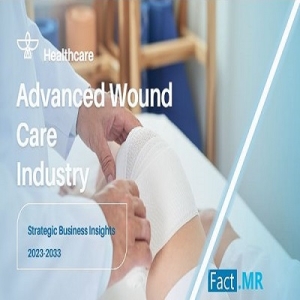Top 5 Companies in Advancements Wound Care Market: Healing for the FuturePosted by Stephen Morrison on September 12th, 2023  Wound care has come a long way from traditional bandages and antiseptics. In recent years, there has been a remarkable transformation in the field of wound management, with a focus on advanced wound care techniques and technologies. These advancements have not only improved the quality of care but have also enhanced the healing process for patients worldwide. In this article, we will explore the latest developments in advanced wound care, drawing insights from key industry reports and analyses. The Evolving Landscape of Wound Care The global wound care market has witnessed significant growth and innovation in recent years. According to a report by NS Medical Devices, the wound care market is one of the fastest-growing segments in the healthcare industry. This growth can be attributed to several factors, including an aging population, an increase in chronic diseases, and a rising awareness of the importance of wound management. One of the key drivers of this growth is the development of advanced wound care products and technologies. These advancements have revolutionized the way wounds are treated, offering more effective and efficient solutions for both acute and chronic wounds. As a result, patients now have access to a wider range of treatment options that promote faster healing and reduce the risk of complications. Key Players in the Advanced Wound Care Market Several major players are at the forefront of the global wound care market. Companies like Smith & Nephew, 3M Healthcare, and Johnson & Johnson are continuously investing in research and development to create cutting-edge wound care products. According to the NS Medical Devices report (1), these companies have a significant market share and are driving innovation in the field. Smith & Nephew, for instance, is known for its advanced wound dressings and negative pressure wound therapy systems. These products are designed to promote optimal wound healing by creating a conducive environment for tissue regeneration. Similarly, 3M Healthcare offers a range of advanced wound care solutions, including transparent dressings and antimicrobial dressings, which help reduce the risk of infection and accelerate the healing process. Johnson & Johnson, a well-established name in healthcare, has also made significant contributions to the advanced wound care market. The company's products, such as advanced wound care dressings and skin closure systems, have set industry standards for effectiveness and patient comfort. Technological Advancements in Wound Care Technological advancements have played a pivotal role in shaping the future of wound care. Innovative products and therapies are constantly being introduced to improve the outcomes for patients with acute and chronic wounds. One notable technological advancement is the use of bioactive dressings. These dressings are designed to provide a controlled release of substances that promote wound healing, such as growth factors and antimicrobial agents. Bioactive dressings not only protect the wound but also stimulate tissue regeneration, leading to faster healing. Another exciting development is the utilization of telemedicine and remote monitoring in wound care. This allows healthcare providers to assess wounds and provide guidance to patients without the need for frequent in-person visits. Remote monitoring devices, including smartphone apps and wearable sensors, enable real-time tracking of wound progress and early detection of complications. Advanced wound care also benefits from the integration of 3D printing technology. Customized wound dressings and implants can be created using 3D printing, ensuring a perfect fit for each patient. This approach has the potential to revolutionize wound care by tailoring treatments to individual needs, improving comfort and efficacy. Bioengineered Tissues and Growth Factors Bioengineered tissues and growth factors are emerging as game-changers in advanced wound care. These innovations harness the power of regenerative medicine to accelerate the healing process for chronic wounds, such as diabetic ulcers and pressure sores. Bioengineered tissues, also known as tissue-engineered skin substitutes, are created in a laboratory using human or animal cells. These substitutes closely resemble natural skin and can be used to cover wounds that do not heal through traditional methods. By providing a scaffold for cell growth, they promote tissue regeneration and wound closure. Growth factors, on the other hand, are proteins that stimulate cell proliferation and tissue repair. They can be applied topically or injected into the wound site to expedite healing. Growth factor therapies have shown promise in enhancing the healing of chronic wounds and reducing the risk of infection. Preventive and Predictive Wound Care In addition to improving wound healing, advanced wound care is also moving towards preventive and predictive strategies. Early detection and intervention can prevent wounds from becoming chronic or developing complications. One approach is the use of advanced imaging techniques, such as infrared thermography and hyperspectral imaging, to detect changes in skin temperature and blood flow. These changes can indicate the presence of underlying issues, such as compromised circulation, that may lead to chronic wounds. Identifying these problems early allows healthcare providers to take proactive measures to prevent wound formation. Predictive analytics and artificial intelligence (AI) are also being integrated into wound care. By analyzing patient data and historical wound outcomes, AI algorithms can predict which individuals are at higher risk of developing chronic wounds. This enables healthcare providers to tailor preventive measures and interventions to those most in need. Advanced wound care has ushered in a new era of wound management, offering patients faster healing, reduced complications, and improved overall quality of life. Key players in the industry, such as Smith & Nephew, 3M Healthcare, and Johnson & Johnson, continue to drive innovation, while technological advancements, bioengineered tissues, growth factors, and predictive strategies are transforming the landscape of wound care. As the global wound care market continues to grow, it is essential for healthcare providers and policymakers to stay informed about these advancements. By embracing the latest technologies and treatment modalities, we can provide better care and outcomes for patients with acute and chronic wounds, ultimately improving their quality of life. Advanced wound care is not just about healing wounds; it's about healing the future of healthcare. Like it? Share it!More by this author |


